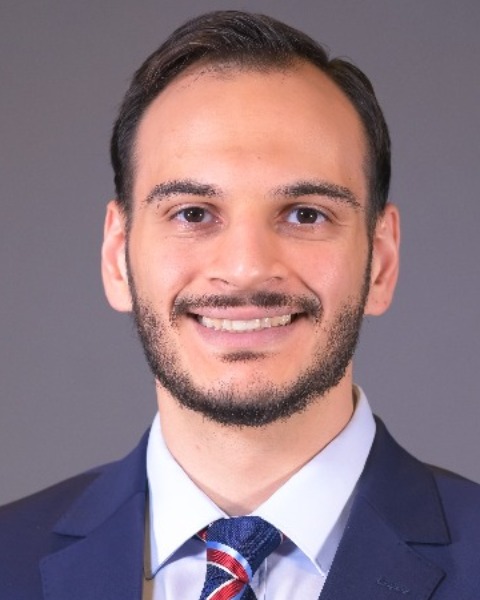Monday Poster Session
Category: Interventional Endoscopy
P3579 - EGD via Gastrostomy Tract
Monday, October 27, 2025
10:30 AM - 4:00 PM PDT
Location: Exhibit Hall

Malik Mushannen, MD
NewYork-Presbyterian / Brooklyn Methodist Hospital
Brooklyn, NY
Presenting Author(s)
Malk Mushannen, MD1, Lillian F. Zhang, MD, PhD2, Evan Grossman, MD2, David Wan, MD3
1NewYork-Presbyterian / Brooklyn Methodist Hospital, Brooklyn, NY; 2NewYork-Presbyterian / Weill Cornell Medical Center, New York, NY; 3NewYork-Presbyterian Hospital/Weill Cornell Medical Center, New York, NY
Introduction: Benign esophageal stenosis occurs in 2-16% of patients after receiving radiation therapy for head and neck cancers (1). Per oral endoscopy is the procedure of choice for upper GI bleed, but anatomic obstructions make this difficult. Here we report on a case of an upper GI bleed requiring endoscopic evaluation via the gastrostomy stoma.
Case Description/
Methods: A 78-year-old gentleman with a past medical history of hypopharyngeal cancer (s/p chemotherapy and radiation), complicated by a benign esophageal stricture s/p PEG tube placement, metastatic gastric cancer, and atrial fibrillation on anticoagulation, presented to the emergency department with weakness and lightheadedness. He reports episodes of bloody bowel movements and bloody emesis. He was hypotensive, tachycardic, and acute anemia with a hemoglobin of 8.5 g/dL (prior hgb 11.6 g/dL). He was appropriately resuscitated with intravenous fluid and blood. He previously presented 8 months earlier for an outpatient endoscopy to evaluate black colored contents in the PEG tube, but an ultra-slim gastroscope was unable to traverse the esophageal stenosis. With his history in mid, per oral endoscopy was attempted for management of his upper GI bleed using an ultra-slim gastroscope, but again this was unsuccessful. As such, the PEG tube was removed, the ultra-slim gastroscope was advanced through the gastrostomy stoma, and the esophagus, stomach and duodenum were evaluated. A nonbleeding duodenal ulcer was found, so the gastrostomy fistula was dilated to 12 mm to accommodate an adult endoscope. Bipolar cautery was subsequently performed with succesful control of bleeding. After completion of the procedure, a 24 F gastrostomy tube was placed. A gastrostomy tube study confirmed appropriate placement of the tube without leakage into the abdominal cavity. The patient subsequently resumed tube feeds with no further decrease in hemoglobin.
Discussion: This case proved to be a challenging case of hemorrhagic shock from upper GI bleed requiring an endoscopy via a gastrostomy tract to perform both diagnostic and therapeutic endoscopy. There have been case reports of utilizing bronchoscopy or ultrathin endoscopy to perform diagnostic endoscopy through a gastrostomy (2, 3). This is one of the first reported cases of performing diagnostic and therapeutic endoscopy via a gastrostomy tract in a patient with anatomic obstruction of the esophagus.
Disclosures:
Malk Mushannen indicated no relevant financial relationships.
Lillian Zhang indicated no relevant financial relationships.
Evan Grossman indicated no relevant financial relationships.
David Wan: Medtronic – Data Monitoring Committee.
Malk Mushannen, MD1, Lillian F. Zhang, MD, PhD2, Evan Grossman, MD2, David Wan, MD3. P3579 - EGD via Gastrostomy Tract, ACG 2025 Annual Scientific Meeting Abstracts. Phoenix, AZ: American College of Gastroenterology.
1NewYork-Presbyterian / Brooklyn Methodist Hospital, Brooklyn, NY; 2NewYork-Presbyterian / Weill Cornell Medical Center, New York, NY; 3NewYork-Presbyterian Hospital/Weill Cornell Medical Center, New York, NY
Introduction: Benign esophageal stenosis occurs in 2-16% of patients after receiving radiation therapy for head and neck cancers (1). Per oral endoscopy is the procedure of choice for upper GI bleed, but anatomic obstructions make this difficult. Here we report on a case of an upper GI bleed requiring endoscopic evaluation via the gastrostomy stoma.
Case Description/
Methods: A 78-year-old gentleman with a past medical history of hypopharyngeal cancer (s/p chemotherapy and radiation), complicated by a benign esophageal stricture s/p PEG tube placement, metastatic gastric cancer, and atrial fibrillation on anticoagulation, presented to the emergency department with weakness and lightheadedness. He reports episodes of bloody bowel movements and bloody emesis. He was hypotensive, tachycardic, and acute anemia with a hemoglobin of 8.5 g/dL (prior hgb 11.6 g/dL). He was appropriately resuscitated with intravenous fluid and blood. He previously presented 8 months earlier for an outpatient endoscopy to evaluate black colored contents in the PEG tube, but an ultra-slim gastroscope was unable to traverse the esophageal stenosis. With his history in mid, per oral endoscopy was attempted for management of his upper GI bleed using an ultra-slim gastroscope, but again this was unsuccessful. As such, the PEG tube was removed, the ultra-slim gastroscope was advanced through the gastrostomy stoma, and the esophagus, stomach and duodenum were evaluated. A nonbleeding duodenal ulcer was found, so the gastrostomy fistula was dilated to 12 mm to accommodate an adult endoscope. Bipolar cautery was subsequently performed with succesful control of bleeding. After completion of the procedure, a 24 F gastrostomy tube was placed. A gastrostomy tube study confirmed appropriate placement of the tube without leakage into the abdominal cavity. The patient subsequently resumed tube feeds with no further decrease in hemoglobin.
Discussion: This case proved to be a challenging case of hemorrhagic shock from upper GI bleed requiring an endoscopy via a gastrostomy tract to perform both diagnostic and therapeutic endoscopy. There have been case reports of utilizing bronchoscopy or ultrathin endoscopy to perform diagnostic endoscopy through a gastrostomy (2, 3). This is one of the first reported cases of performing diagnostic and therapeutic endoscopy via a gastrostomy tract in a patient with anatomic obstruction of the esophagus.
Disclosures:
Malk Mushannen indicated no relevant financial relationships.
Lillian Zhang indicated no relevant financial relationships.
Evan Grossman indicated no relevant financial relationships.
David Wan: Medtronic – Data Monitoring Committee.
Malk Mushannen, MD1, Lillian F. Zhang, MD, PhD2, Evan Grossman, MD2, David Wan, MD3. P3579 - EGD via Gastrostomy Tract, ACG 2025 Annual Scientific Meeting Abstracts. Phoenix, AZ: American College of Gastroenterology.
